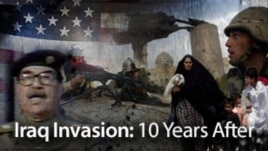When Reuters photographer Namir Noor-Eldeen rushed to the scene of a battle in eastern Baghdad on July 12, 2007, he had no idea the story eventually would introduce the world to a new online publisher of secret information.
He also didn't know the information the Pentagon would try to keep secret would be about his death.
Noor-Eldeen and his driver, Said Chmagh, were among a group of at least 10 Iraqi men killed that day when a U.S. Apache helicopter mistook them for armed militants. Two children inside their van were also injured in the attack.
It was the U.S. military's failed attempts to cover up the tragedy that catapulted WikiLeaks to international fame.
Reuters and other media organizations spent more than two years trying to get the Pentagon to disclose how Noor-Eldeen was killed. But the Pentagon declared that vital information in the case was classified.
That information was gun-sight video footage from one of the helicopters showing Noor-Eldeen and others in the group being fired upon and killed. It included audio of the helicopter crew's radio communications.
WikiLeaks said it obtained the video from an anonymous whistle-blower in the U.S. military.
'Collateral Murder'
The group released edited versions of the video on April 5, 2010, on a website it called Collateral Murder.
Attention over the story, WikiLeaks' first international scoop, put it in a position to collect more classified information from whistle-blowers around the world.
 WikiLeaks founder Julian Assange told RFE/RL at the time that his group would always protect the anonymity of contributing whistle-blowers.
WikiLeaks founder Julian Assange told RFE/RL at the time that his group would always protect the anonymity of contributing whistle-blowers.
"We make a promise to our sources," Assange said. "One, that we will do everything in our power technically and legally to protect them. Two, that we are going to maximize the impact of the submissions that they make to us."
Eventually, the source of the leak was identified by the Pentagon as military intelligence analyst Bradley Manning. He was promptly arrested and charged with "aiding the enemy."
'Delightful Bloodlust'
Freedom-of-information advocates argue the charges are aimed at intimidating other would-be whistle-blowers.
Manning's motivation for leaking the video was revealed this month when the Freedom of the Press Foundation released a recording of his statement to a military court at his arraignment.
Manning said he was troubled by audio of the helicopter crew's conversations, as well as a second attack they made against an unarmed van and wounded man.
"It was clear to me that the event happened because the aerial weapons team mistakenly identified Reuters employees as a potential threat and that the people in the [van] were merely attempting to assist the wounded," Manning said. "The people in the [van] were not a threat but merely Good Samaritans.
"The most alarming aspect of the video, however, was the seemingly delightful bloodlust the aerial weapons crew appeared to have. They dehumanized the individuals they were engaging and seemed to not value human life by referring to them as 'dead bastards' and congratulating each other on the ability to kill in large numbers."
Manning said their conversation was "similar to a child torturing ants with a magnifying glass."
His court-martial is scheduled for June. If convicted, he could be sentenced to life in prison.
Virtual Prisoner
For its part, WikiLeaks has continued to gather and release classified U.S. government documents and diplomatic cables. In July 2010, its "Afghan War Diary" release compiled some 77,000 previously unreleased documents about the war in Afghanistan.
In October 2010, it began to release 400,000 documents from Iraq, the "Iraq War Logs," in cooperation with private media organizations.
In November 2010, working together with international media companies, WikiLeaks started issuing edited diplomatic dispatches leaked from the U.S. State Department.
By then, Assange had been arrested in England on a Swedish warrant for alleged sexual misconduct in Stockholm. His lawyers argued that the allegations were aimed at keeping him jailed while the United States prepared to extradite and prosecute him for his WikiLeaks work.
Released on bail, Assange fled to Ecuador's Embassy in London and was granted political asylum. He continues to live there as a virtual prisoner, with British police waiting to arrest him the moment he steps outside the embassy.
He also didn't know the information the Pentagon would try to keep secret would be about his death.
Noor-Eldeen and his driver, Said Chmagh, were among a group of at least 10 Iraqi men killed that day when a U.S. Apache helicopter mistook them for armed militants. Two children inside their van were also injured in the attack.
It was the U.S. military's failed attempts to cover up the tragedy that catapulted WikiLeaks to international fame.
Reuters and other media organizations spent more than two years trying to get the Pentagon to disclose how Noor-Eldeen was killed. But the Pentagon declared that vital information in the case was classified.
That information was gun-sight video footage from one of the helicopters showing Noor-Eldeen and others in the group being fired upon and killed. It included audio of the helicopter crew's radio communications.
WikiLeaks said it obtained the video from an anonymous whistle-blower in the U.S. military.
'Collateral Murder'
The group released edited versions of the video on April 5, 2010, on a website it called Collateral Murder.
Attention over the story, WikiLeaks' first international scoop, put it in a position to collect more classified information from whistle-blowers around the world.
"We make a promise to our sources," Assange said. "One, that we will do everything in our power technically and legally to protect them. Two, that we are going to maximize the impact of the submissions that they make to us."
Eventually, the source of the leak was identified by the Pentagon as military intelligence analyst Bradley Manning. He was promptly arrested and charged with "aiding the enemy."
'Delightful Bloodlust'
Freedom-of-information advocates argue the charges are aimed at intimidating other would-be whistle-blowers.
Manning's motivation for leaking the video was revealed this month when the Freedom of the Press Foundation released a recording of his statement to a military court at his arraignment.
Manning said he was troubled by audio of the helicopter crew's conversations, as well as a second attack they made against an unarmed van and wounded man.
"It was clear to me that the event happened because the aerial weapons team mistakenly identified Reuters employees as a potential threat and that the people in the [van] were merely attempting to assist the wounded," Manning said. "The people in the [van] were not a threat but merely Good Samaritans.
MORE ICONS OF IRAQ WAR: Lynndie England And Prisoner Abuse
"The most alarming aspect of the video, however, was the seemingly delightful bloodlust the aerial weapons crew appeared to have. They dehumanized the individuals they were engaging and seemed to not value human life by referring to them as 'dead bastards' and congratulating each other on the ability to kill in large numbers."
Manning said their conversation was "similar to a child torturing ants with a magnifying glass."
MORE ICONS OF IRAQ WAR: Shoe-Thrower Muntadhar Al-Zaidi
His court-martial is scheduled for June. If convicted, he could be sentenced to life in prison.
Virtual Prisoner
For its part, WikiLeaks has continued to gather and release classified U.S. government documents and diplomatic cables. In July 2010, its "Afghan War Diary" release compiled some 77,000 previously unreleased documents about the war in Afghanistan.
In October 2010, it began to release 400,000 documents from Iraq, the "Iraq War Logs," in cooperation with private media organizations.
In November 2010, working together with international media companies, WikiLeaks started issuing edited diplomatic dispatches leaked from the U.S. State Department.
MORE ICONS OF IRAQ WAR: Ali Ismail Abbas And The Civilian Toll
By then, Assange had been arrested in England on a Swedish warrant for alleged sexual misconduct in Stockholm. His lawyers argued that the allegations were aimed at keeping him jailed while the United States prepared to extradite and prosecute him for his WikiLeaks work.
Released on bail, Assange fled to Ecuador's Embassy in London and was granted political asylum. He continues to live there as a virtual prisoner, with British police waiting to arrest him the moment he steps outside the embassy.





